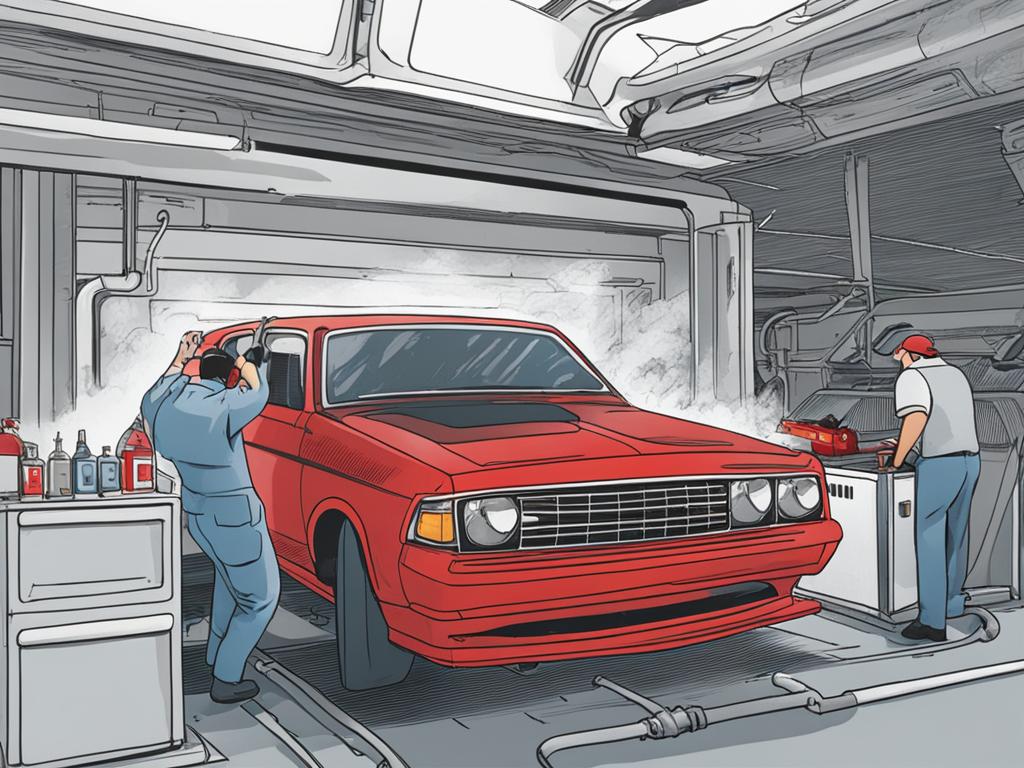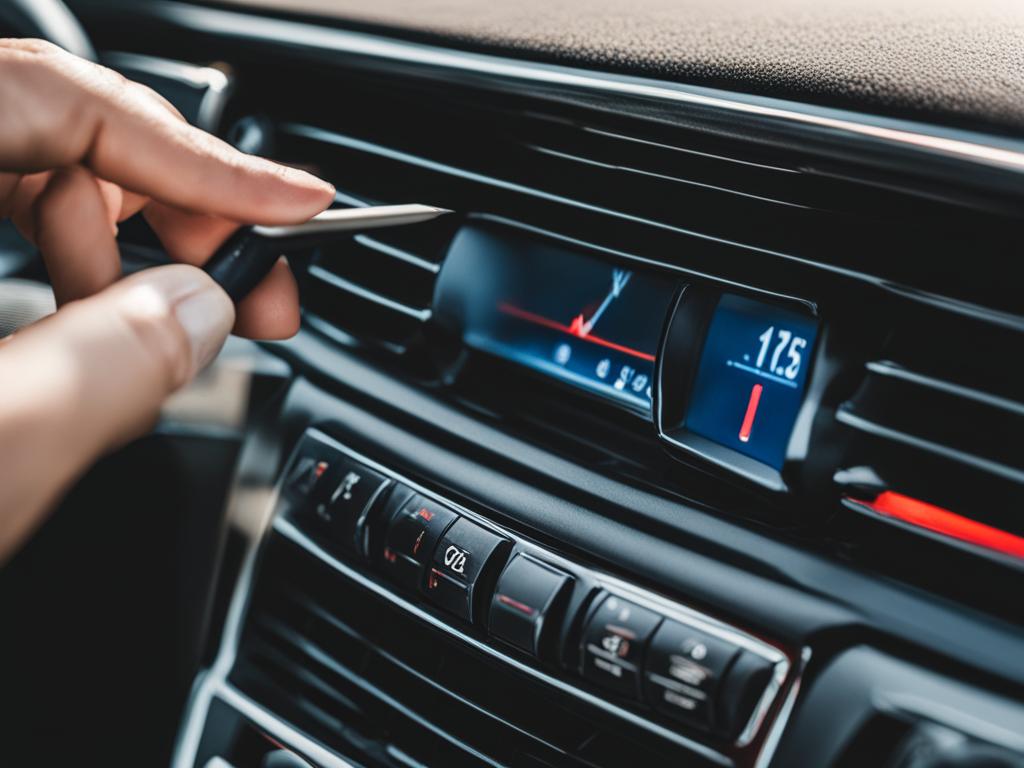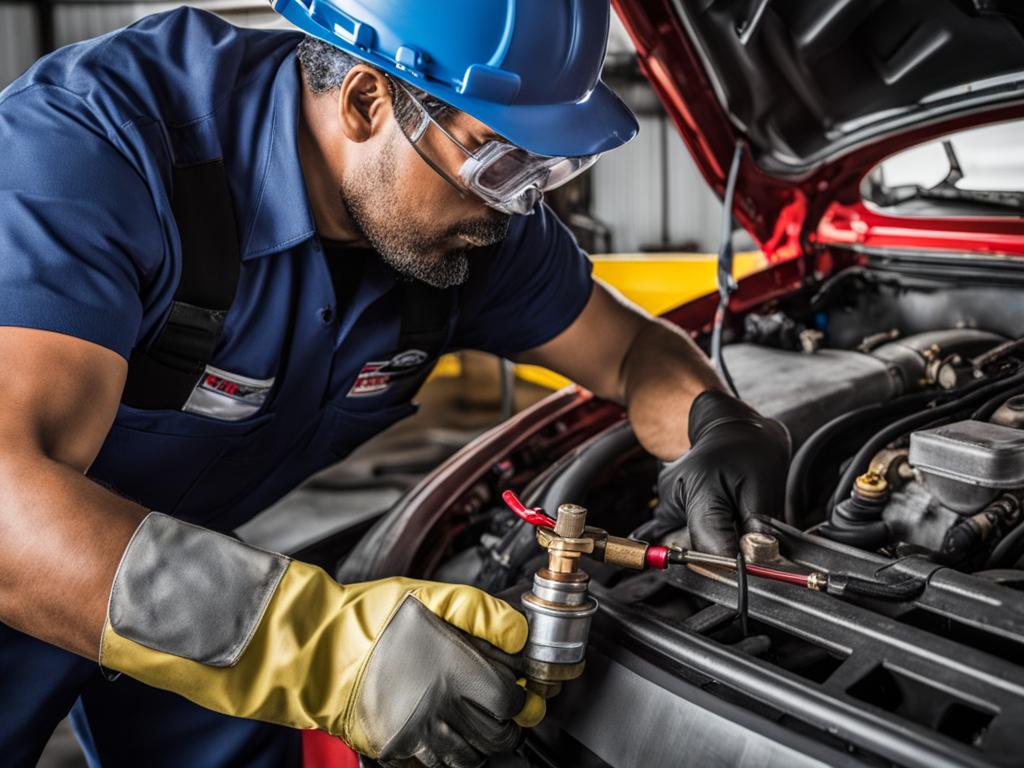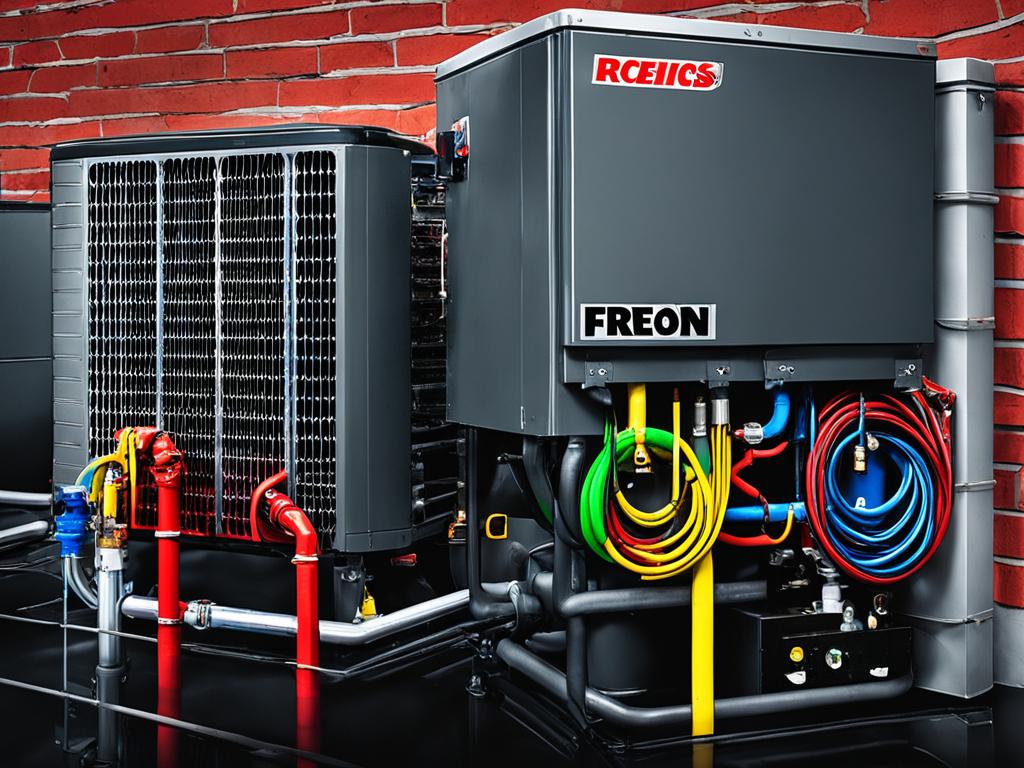Fix Overcharged AC: Bleed It Off Safely
If you add more refrigerant to your vehicle’s air conditioner than needed, it results in an overcharged AC. The excess product from the system can be removed by bleeding the vehicle’s air conditioner.
Overcharging the AC can lead to various issues such as faulty cooling, compressor problems, and increased pressure. It is important to safely bleed off the overcharged AC to restore optimal performance and prevent potential damage to the system.
In this article, we will provide a step-by-step guide to safely bleed off an overcharged AC, how to detect if your AC is overcharged, and the importance of professional handling for AC issues. We will also address common questions about releasing excess refrigerant and the dangers of DIY AC recharging.
Key Takeaways:
- Overcharged AC occurs when too much refrigerant is added to the system, leading to issues with cooling and compressor performance.
- To safely bleed off an overcharged AC, follow a step-by-step procedure using a recharge kit and gauge.
- Signs of an overcharged AC include insufficient cooling, compressor noise, and engine issues.
- It is important to seek professional assistance for AC issues to ensure proper refrigerant handling and system maintenance.
- DIY AC recharging can be risky and may lead to overcharged ACs and system damage.
Step-by-Step Guide to Bleed off an Overcharged AC
Follow these steps to safely bleed off an overcharged AC:
- Park the car and expose the engine while it’s still running.
- Attach the recharge kit without the refrigerant container to the appropriate terminal.
- Turn on the gauge on the recharge kit to remove excess refrigerant.
- Once the arrow points to the green area, press the handle on the gauge repeatedly to remove additional refrigerant.
- If the gauge’s arrow is stable in the green area, check the car’s AC if it’s now producing cold air.
How Did You Come To Know That Your AC Is Overcharged?
There are several signs and symptoms that indicate your car’s AC is overcharged. By recognizing these indicators, you can take the necessary steps to rectify the issue and ensure your AC system performs optimally.
- No cooling even after 5 to 10 minutes of running the AC: One of the clear signs of an overcharged car AC is the lack of cooling even after the system has been running for a while. If you notice that the air blowing from the vents remains warm or lukewarm, it may indicate an overcharged AC.
- Noise from the compressor, indicating mechanical issues: An overcharged AC can put additional strain on the compressor, leading to mechanical issues. If you hear unusual noises coming from the compressor area, such as grinding or squealing sounds, it may be a sign of overcharging.
- Engine issues, such as increased power demand and noise from the drive belt: Overcharged AC can cause increased power demand from the engine, which may result in engine performance issues. Additionally, a noisy drive belt can indicate the presence of excessive refrigerant in the AC system.
It’s important to pay attention to these symptoms as ignoring an overcharged AC can lead to further damage and costly repairs. If you notice any of these signs, it’s recommended to take your car to a professional mechanic for a proper diagnosis and solution.
To visually demonstrate the symptoms of an overcharged car AC, refer to the table below:
| Signs of an Overcharged Car AC | How to Determine if AC Is Overcharged |
|---|---|
| No cooling even after 5 to 10 minutes of running the AC | Lack of cold air from the vents |
| Noise from the compressor | Grinding or squealing sounds |
| Engine issues | Increased power demand, noisy drive belt |

How to Bleed off an Overcharged Car AC?
To safely bleed off an overcharged car AC, follow these steps:
- Open all windows and sunroofs of your vehicle.
- Turn on the fan to its highest setting.
This allows the wind to cool down the car by dissipating the heat and helps release excess refrigerant from the AC system.
Remember to exercise caution while bleeding off an overcharged AC to prevent any harm or injury.
More Tips for Venting an Overcharged Car AC
Here are some additional tips to ensure a safe and effective process:
- Wear protective goggles and gloves to avoid direct contact with refrigerant.
- Follow the manufacturer’s instructions and safety guidelines when using AC recharge kits.
- If you are unsure about the process or lack experience, it is recommended to seek professional assistance.
By following these steps and guidelines, you can safely release excess refrigerant from your overcharged car AC and restore its optimal performance.
FAQs About the Overcharged AC
Having an overcharged AC in your car can be a frustrating issue. To help you better understand this problem, we have gathered some frequently asked questions and their answers.
Q. Can I Release Freon From the Car Air Conditioner?
A. Yes, it is possible to release Freon from a car air conditioner. However, it requires the use of an AC recovery machine. These machines can range in cost from $400 to $20,000, depending on the quality and features.
Releasing refrigerant from your car AC requires proper equipment and knowledge. It is essential to follow safety guidelines and regulations to prevent harm to yourself, others, and the environment. Consulting a professional mechanic is recommended for the safe handling and disposal of refrigerant.
It is important to note that Freon, also known as R12 refrigerant, has been phased out due to its harmful effects on the ozone layer. R134a refrigerant is the standard coolant used in modern car AC systems.

The Dangers of DIY AC Recharging
Many car owners attempt to recharge their ACs themselves using inexpensive, faulty coolant cans and unreliable pressure gauges. DIY recharging can lead to overcharged ACs and potential damage to the system.
One of the dangers of DIY AC recharging is the risk of overcharging the car AC. Overcharging occurs when too much refrigerant is added to the system, exceeding its capacity. This can result in excessive pressure buildup, which can damage the AC components, including the compressor and seals.
Improper handling of refrigerant is another hazard of DIY AC recharging. Refrigerants are toxic and harmful to the environment. If not handled correctly, they can leak into the atmosphere, contributing to air pollution and depleting the ozone layer. In addition, mishandling refrigerants can lead to personal injury or health risks due to their chemical properties.
“Attempting to recharge your car AC without proper knowledge and tools can lead to more harm than good. It’s essential to seek professional assistance to ensure the safe and efficient functioning of your AC system.”
Trustworthy professionals have the knowledge, expertise, and equipment required to handle refrigerants safely. They can accurately determine the right amount of refrigerant needed for your car AC and ensure proper installation without the risk of overcharging. Professional mechanics also have the necessary tools and gauges to monitor the pressure levels and prevent any potential hazards.
Don’t put your safety and AC system at risk. It’s best to leave the AC recharging and maintenance tasks to qualified professionals who can safeguard your investment and optimize the performance of your car’s cooling system.
The Risks of Overcharging a Car AC
Overcharging a car AC poses several risks:
- Damage to the system: Overcharging can lead to increased pressure levels, potentially causing damage to the AC components, such as the compressor, condenser, or expansion valve.
- Poor cooling performance: An overcharged AC may not cool properly, resulting in reduced cooling effectiveness and discomfort during hot weather.
- System malfunction: Excessive refrigerant can disrupt the normal functioning of the AC system, leading to frequent breakdowns or malfunctions.
- Increased energy consumption: Overcharged AC systems may consume more energy to operate, leading to higher fuel consumption and increased costs.
It’s crucial to avoid DIY AC recharging and seek professional assistance to prevent these risks and ensure the optimal functioning of your car’s AC system.
Understanding Overcharged AC in Cars
Overcharged AC in cars occurs when too much refrigerant is added to the system. This can happen due to various reasons, including inexperienced DIY recharging and the use of faulty gauges. When the AC system is overcharged, it can have detrimental effects on its cooling functionality and lead to several consequences.
Causes of Overcharged Car AC:
- Inexperienced DIY recharging: Many car owners attempt to recharge their AC systems without proper knowledge and expertise, resulting in the overcharging of the system.
- Faulty gauges: Using inaccurate or faulty gauges can lead to the incorrect measurement of refrigerant levels, causing an overcharged AC.
Consequences of Overcharging AC System:
Overcharging the AC system can have various consequences, affecting both the performance of the AC and the overall functioning of the car. Some of the common consequences include:
- Faulty cooling: An overcharged AC may not be able to cool the car efficiently, resulting in insufficient cooling during hot weather.
- Compressor issues: Excess refrigerant can put excessive strain on the AC compressor, leading to mechanical issues and potential compressor failure.
- High pressure: Overcharging the AC system can cause the refrigerant pressure to rise beyond optimal levels, which can damage various components of the AC system.
- Engine problems: The overcharged AC system can increase the workload on the engine, reducing its performance and potentially causing overheating.
To prevent the overcharging of your car’s AC system and avoid these consequences, it is essential to consult a professional mechanic who can accurately recharge the AC with the appropriate amount of refrigerant.

Signs and Symptoms of Overcharged Car AC
When your car AC is overcharged, it can result in various signs and symptoms that indicate an excessive amount of refrigerant in the system. Recognizing these indicators is important for identifying the issue and taking appropriate action. Common signs of an overcharged car AC include:
- Faulty Cooling: The AC may blow warm or mildly cool air instead of cold air, even after running it for an extended period.
- Noisy or Broken Compressors: Overcharging the AC can put excessive strain on the compressor, leading to unusual noises or a complete malfunction.
- High Pressure Readings: A pressure gauge connected to the AC system may show abnormally high pressure readings, indicating an overcharged condition.
- Engine Performance Issues: Overcharged AC can affect the engine’s performance, resulting in decreased power, increased load demand, or noise from the drive belt.
It is crucial to monitor these signs and symptoms and address the issue promptly to avoid further damage to the AC system and ensure optimal cooling performance.

Expert Insight:
“Recognizing the signs of an overcharged car AC is essential to prevent potential damage to the system. If you notice faulty cooling, strange noises from the compressor, high pressure readings, or engine performance issues, it’s crucial to have a professional check and rectify the overcharged AC.”
Professional Mechanic vs. DIY Fix for Overcharged AC
When facing an overcharged AC, it is important to carefully consider whether to attempt a DIY fix or seek the assistance of a professional mechanic. While a DIY approach may seem cost-effective and convenient, it is crucial to understand the advantages and limitations of each option.
The Advantages of Professional Mechanic for Overcharged AC
Opting for a professional mechanic to fix an overcharged AC offers several advantages:
- Expertise and Experience: Professional mechanics have extensive knowledge and experience in identifying and resolving issues with overcharged AC systems. They are trained to handle refrigerant safely and efficiently.
- Proper Equipment: Licensed mechanics have access to specialized tools and equipment needed to diagnose and fix overcharged AC systems effectively. They can ensure the proper removal of excess refrigerant without causing further damage to the system.
- Compliance with Legal Regulations: Handling and disposing of refrigerant can be subject to legal regulations. Professional mechanics are well-versed in these regulations and can ensure compliance, avoiding any potential legal issues.
- Peace of Mind: By entrusting the repair to a professional, you can have peace of mind knowing that your AC system is in capable hands. Professionals can provide warranties and guarantees for their work, offering reassurance in case any further issues arise.
The Pros and Cons of DIY Fix for Overcharged Car AC
DIY alternatives for fixing an overcharged car AC have their own set of pros and cons:
- Lower Cost: DIY fixes can be more economical, as you can avoid labor costs associated with professional services.
- Inconvenience: DIY fixes may require purchasing specialized equipment and learning unfamiliar procedures, which can be time-consuming and challenging.
- Risk of Mishandling: Handling refrigerant without proper knowledge and equipment can be hazardous. Improper handling may result in refrigerant leaks, environmental harm, or personal injuries.
- Limited Resources: DIY fixes rely on readily available resources and may not be suitable for complex or severe overcharging issues. Professional mechanics have access to a wide range of resources and technical expertise.
In the case of an overcharged AC, the expertise, experience, and proper equipment of a professional mechanic offer significant advantages over a DIY fix. It is crucial to prioritize safety, compliance, and long-term reliability when addressing overcharging issues in your car’s AC system.

Seeking professional help for overcharging your car AC is essential for ensuring a reliable and effective solution. With their expertise and access to specialized tools, professional mechanics can safely and efficiently remove excess refrigerant, restoring your AC system to its optimal functioning state.
How a Licensed Mechanic Discharges an Overcharged Car AC
When it comes to fixing an overcharged car AC, the process of discharging excess refrigerant should be left to licensed mechanics. These professionals utilize specialized equipment to ensure a safe and effective removal of the overcharged refrigerant from the system.
One of the key pieces of equipment used by licensed mechanics is an airtight vacuum. This vacuum is designed to create a seal around the AC system, allowing the mechanic to extract the excess refrigerant. By creating a vacuum, the mechanic can safely bleed off the overcharged AC without releasing any refrigerant into the environment. This is crucial for both safety reasons and to comply with environmental regulations.
“Licensed mechanics use airtight vacuums to safely and effectively discharge excess refrigerant.”
Additionally, licensed mechanics also have the necessary seals and connectors to properly attach the vacuum to the AC system. These seals ensure a tight and secure connection, minimizing the risk of leaks during the discharging process.
Once the excess refrigerant is collected, licensed mechanics store it in a container for recycling or reuse. This responsible approach helps to reduce waste and minimize the environmental impact of discharging overcharged AC systems. By recycling or reusing the refrigerant, licensed mechanics contribute to the sustainability and conservation of resources.
Overall, the process of discharging an overcharged car AC by a licensed mechanic involves utilizing specialized equipment, creating a vacuum, and safely collecting the excess refrigerant for recycling or reuse. This professional approach ensures the safe and effective resolution of an overcharged AC while prioritizing environmental sustainability.

The Difference Between Refrigerant and Freon
Understanding the terms “refrigerant” and “Freon” is essential when it comes to car AC systems. While these terms are often used interchangeably, there is a difference between them.
Refrigerant refers to the substance used in air conditioning systems to absorb heat from the indoor air and release it outside, creating a cooling effect. It is a chemical compound specifically designed for heat transfer and is vital for the proper functioning of an AC system.
Freon, on the other hand, is a specific brand name for a type of refrigerant called R12. It was widely used in older car AC systems due to its excellent cooling properties. However, Freon has been banned worldwide because it contains chlorofluorocarbons (CFCs), which are harmful to the ozone layer.

Due to the environmental concerns associated with Freon, it is no longer used in car AC systems. Instead, a different refrigerant known as R134a was introduced as a replacement. R134a refrigerant is considered more environmentally friendly and is the standard coolant used in modern car AC systems.
It’s important to understand this difference to ensure the proper maintenance and repair of your car’s AC system. Using the correct refrigerant is crucial for both performance and environmental reasons.
Importance of Professional Handling for Overcharged AC
Proper handling of refrigerant is crucial when dealing with an overcharged AC system. Not only does it ensure the safety of individuals, but it also helps protect the environment. That is why it is essential to rely on professional mechanics who possess the necessary knowledge, training, and equipment to handle this task with expertise.
Improper handling of refrigerant can lead to various risks and consequences. The excess refrigerant, if not removed correctly, can cause damage to the AC system, resulting in expensive repairs or even the need for a complete replacement. Moreover, mishandling refrigerant poses a threat to personal safety, as it is a chemical substance that can be harmful when exposed to skin or eyes.
“Professional mechanics are equipped with the expertise to effectively and safely remove excess refrigerant from an overcharged AC system, minimizing the risks and preventing further damage.”
By relying on professionals, you can have peace of mind knowing that the overcharged AC issue will be addressed efficiently and safely. Professional mechanics follow industry-standard procedures to remove excess refrigerant without causing any harm. They also possess the necessary equipment, such as recovery machines, to ensure the proper collection and recycling of refrigerant, reducing its impact on the environment.
Additionally, seeking professional help for removing excess refrigerant from an overcharged AC system is crucial due to legal restrictions surrounding refrigerant handling. In many regions, individuals without the appropriate certifications are prohibited from handling refrigerants, as this helps prevent unauthorized and unsafe disposal, reducing the overall environmental impact caused by improper refrigerant handling.
Overall, the importance of professional handling for an overcharged AC system cannot be overstated. It ensures safety, protects the environment, and guarantees the proper removal of excess refrigerant, minimizing the risks and potential damage associated with an overcharged AC.

Risks of Improper Handling of Refrigerant
| Risks | Consequences |
|---|---|
| Damage to AC system | Potential costly repairs or replacement |
| Personal safety hazards | Risk of chemical exposure and harm |
| Environmental impact | Inappropriate disposal leading to pollution |
Conclusion
To maintain optimal performance and prevent system damage, it is crucial to safely bleed off an overcharged AC. Seeking professional assistance is highly recommended as it ensures the proper handling of refrigerant and reduces the risk of mishaps. Regular AC maintenance and professional help play a significant role in maintaining a well-functioning and efficient car AC system.
By safely removing excess refrigerant from an overcharged AC, you can restore the functionality of your car’s cooling system. The process of bleeding off an overcharged AC requires specialized knowledge and equipment, which professionals possess. Their expertise guarantees the safe removal and disposal of refrigerant, following environmental regulations.
Additionally, regular AC maintenance is essential for the longevity of your car’s AC system. Professionals can identify potential issues early on and provide preventive maintenance, saving you from costly repairs down the line. Their assistance not only ensures the proper functioning of your AC but also enhances your overall driving experience, especially during hot summer months.
FAQ
Can I Release Freon From the Car Air Conditioner?
You can release Freon from the car air conditioner, but it requires an AC recovery machine that may cost between $400 and $20,000.
What are some signs and symptoms of an overcharged car AC?
Signs and symptoms of an overcharged car AC include faulty cooling, noisy or broken compressors, high pressure readings, and engine performance issues.
How can I safely bleed off an overcharged car AC?
To safely bleed off an overcharged car AC, park the car and expose the engine while it’s still running. Then, attach the recharge kit without the refrigerant container to the appropriate terminal. Turn on the gauge on the recharge kit to remove excess refrigerant. If the arrow on the gauge points to the green area, press the handle on the gauge repeatedly to remove additional refrigerant. Finally, check if the car’s AC is now producing cold air.




